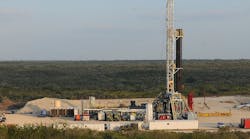Seismic data that are not several decades old are needed before the US Minerals Management Service’s new 5-year plan for Outer Continental Shelf oil and gas leasing is acceptable, a House subcommittee chairman said as he opened a hearing on the plan.
“During debate on the House floor this week, it was said that 80% of the known resources on the OCS are available for drilling. I believe that’s accurate, but I believe it’s based on figures that are decades old,” said Rep. Jim Costa (D-Calif.), who chairs the Natural Resources Committee’s Energy and Mineral Resources Subcommittee. “That information needs to be updated.”
Costa said too much of the debate on both sides of the aisle “has been focused on ambiguity, assumptions, and vigorously debated arguments,” adding “We can have a more robust level of discussion with more-accurate-information.”
Acting MMS Director Walter D. Cruickshank confirmed that MMS had to use seismic surveys shot in the late 1970s and early 1980s as it considered possibly including offshore Virginia in the 2007-12 OCS plan. He said MMS also considered seismic data from adjacent areas off Canada and the Bahamas, but said, “Until more work is done out there, it is not very good information,” he said.
Companies that historically have supplied such information to the government aren’t likely to pay for new surveys if an area is not going to be leased, Cruickshank said. “We don’t do our own surveys. To do so for any given planning area would take $50-85 million and several years of processing. We have 26 planning areas, although there is more-recent data from places like the central and western Gulf of Mexico, where there has been oil and gas activity,” he said.
New seismic data are needed because the technology has improved so dramatically in the last 25 years, said Rep. Stevan Pearce (R-NM), the subcommittee’s chief minority member. “Back then, you got only a one-dimensional picture.” he said.
Still off-limits
When Pearce asked Cruickshank if he thought companies would shoot new seismic surveys if OCS acreage off Virginia was removed from an existing congressional moratorium and presidential withdrawal, he said he thought that companies would. He added that MMS would not begin to prepare for a lease sale there while the bans are in place.
Pearce said several members of New Jersey’s congressional delegation have expressed concern over the possibility of a spill in the proposed leasing area off Virginia reaching their state’s coast. “Currents running immediately offshore Virginia are southerly and, farther out, run straight out to sea. We believe the chances that a spill would reach New Jersey’s coast are minimal,” Cruickshank replied.
“Including Virginia in the 5-year plan will provide answers. It would be short-sighted not to seek them, as I believe the majority of Americans want to know how extensive our domestic resources are,” said one witness, Rep. Thelma Drake (R-Va.), a former subcommittee member whose district includes much of Virginia’s coast.
She and Virginia State Sen. Frank Wagner (R-Virginia Beach) separately noted that the state sought assurances in its energy plan that any federal leasing would take place an appropriate distance from shore. They criticized the new 5-year plan because it gives the state a much smaller potential federal leasing area because of Virginia’s concave coast.
But Drake reiterated that it’s important to learn just how much natural gas is out there. “All the renewable energy we could produce won’t keep our homes warm and our lights on. We must allow MMS to determine how extensive our OCS resources are,” she maintained.
Not every Virginian supports OCS leasing off the state’s coast. Albert Pollard, a former member of Virginia’s house of delegates, told the subcommittee that outside the Virginia Beach region in Wagner’s district, the state has the largest coastal pristine acreage on the eastern seaboard. Production from offshore leases would not occur for at least 10 years, he added.
